Understanding Business Environment
VerifiedAdded on 2020/06/06
|14
|4006
|265
AI Summary
This assignment delves into the concept of the business environment, examining both internal and external factors that shape organizational performance. Students are expected to analyze diverse elements within these environments, such as market trends, competition, government regulations, technological advancements, and organizational structure, to understand their impact on businesses. The assignment encourages critical thinking about how organizations can effectively navigate and adapt to these dynamic influences for success.
Contribute Materials
Your contribution can guide someone’s learning journey. Share your
documents today.
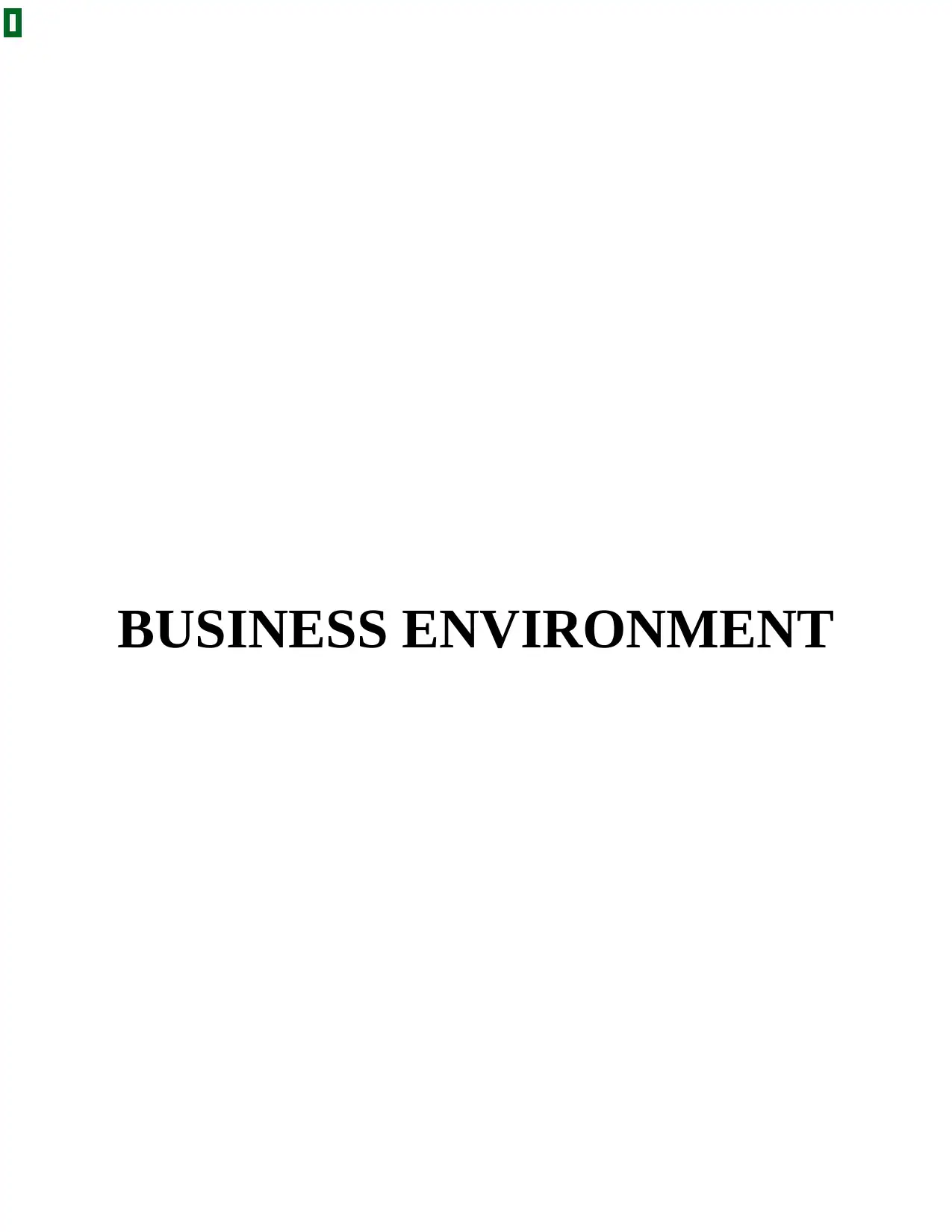
BUSINESS ENVIRONMENT
Secure Best Marks with AI Grader
Need help grading? Try our AI Grader for instant feedback on your assignments.
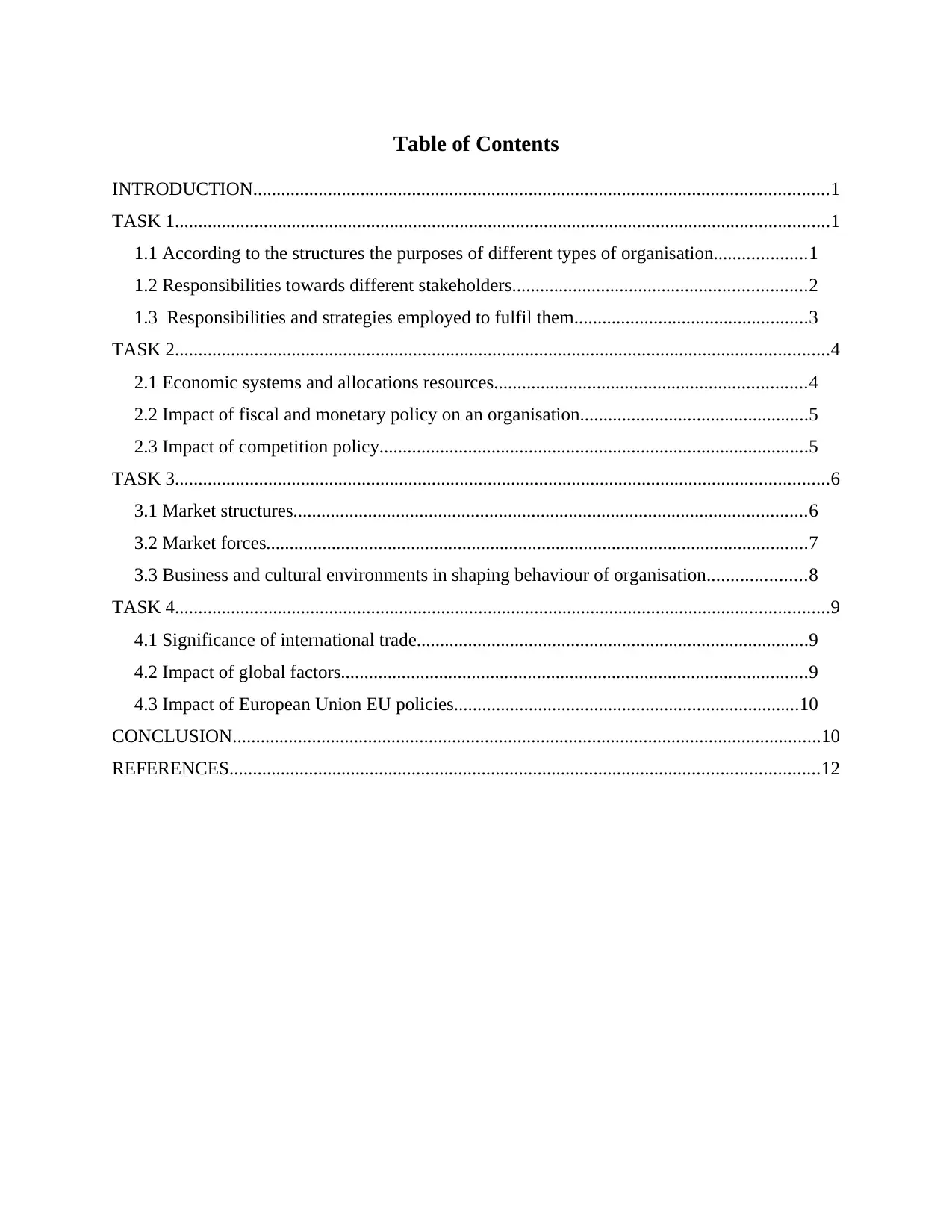
Table of Contents
INTRODUCTION...........................................................................................................................1
TASK 1............................................................................................................................................1
1.1 According to the structures the purposes of different types of organisation....................1
1.2 Responsibilities towards different stakeholders...............................................................2
1.3 Responsibilities and strategies employed to fulfil them..................................................3
TASK 2............................................................................................................................................4
2.1 Economic systems and allocations resources...................................................................4
2.2 Impact of fiscal and monetary policy on an organisation.................................................5
2.3 Impact of competition policy............................................................................................5
TASK 3............................................................................................................................................6
3.1 Market structures..............................................................................................................6
3.2 Market forces....................................................................................................................7
3.3 Business and cultural environments in shaping behaviour of organisation.....................8
TASK 4............................................................................................................................................9
4.1 Significance of international trade....................................................................................9
4.2 Impact of global factors....................................................................................................9
4.3 Impact of European Union EU policies..........................................................................10
CONCLUSION..............................................................................................................................10
REFERENCES..............................................................................................................................12
INTRODUCTION...........................................................................................................................1
TASK 1............................................................................................................................................1
1.1 According to the structures the purposes of different types of organisation....................1
1.2 Responsibilities towards different stakeholders...............................................................2
1.3 Responsibilities and strategies employed to fulfil them..................................................3
TASK 2............................................................................................................................................4
2.1 Economic systems and allocations resources...................................................................4
2.2 Impact of fiscal and monetary policy on an organisation.................................................5
2.3 Impact of competition policy............................................................................................5
TASK 3............................................................................................................................................6
3.1 Market structures..............................................................................................................6
3.2 Market forces....................................................................................................................7
3.3 Business and cultural environments in shaping behaviour of organisation.....................8
TASK 4............................................................................................................................................9
4.1 Significance of international trade....................................................................................9
4.2 Impact of global factors....................................................................................................9
4.3 Impact of European Union EU policies..........................................................................10
CONCLUSION..............................................................................................................................10
REFERENCES..............................................................................................................................12
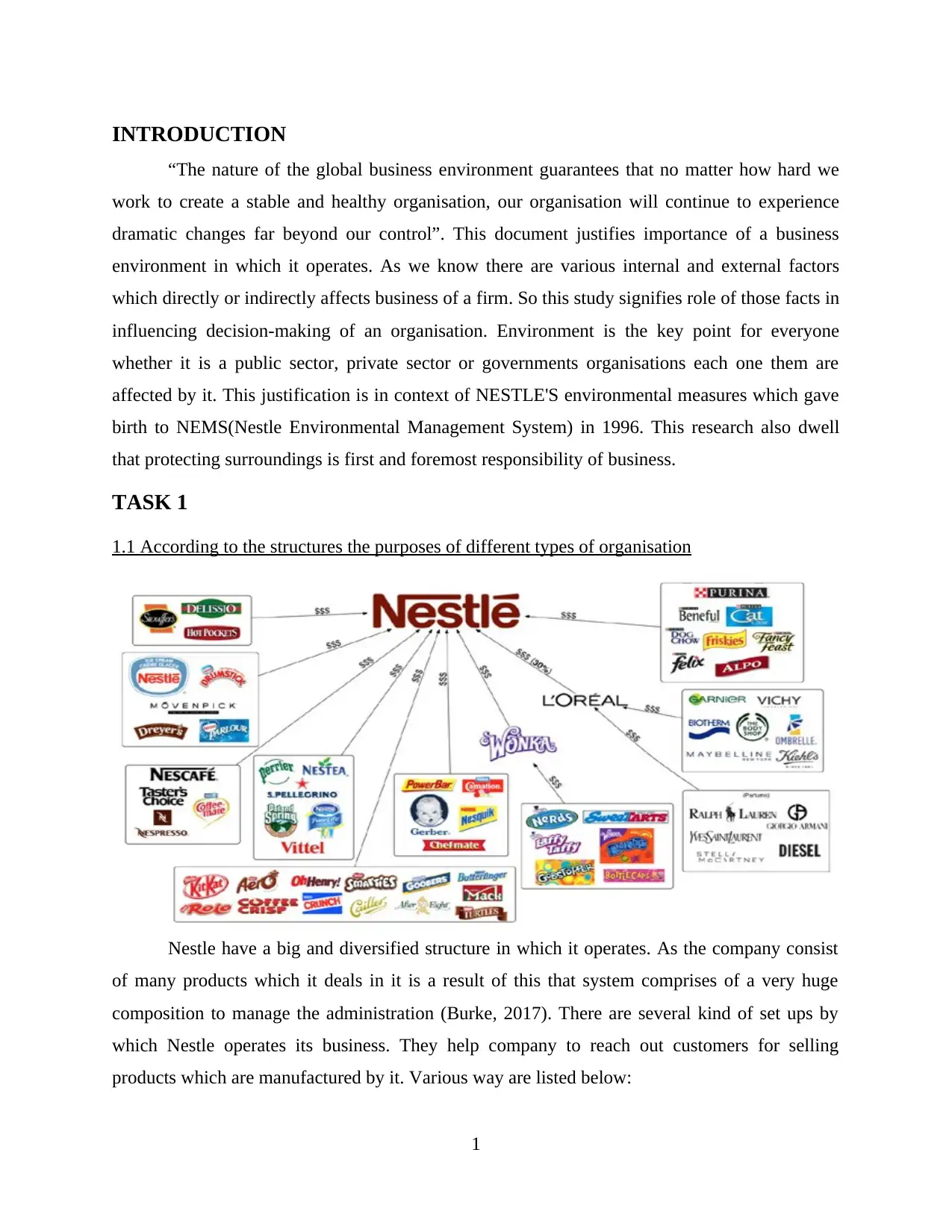
INTRODUCTION
“The nature of the global business environment guarantees that no matter how hard we
work to create a stable and healthy organisation, our organisation will continue to experience
dramatic changes far beyond our control”. This document justifies importance of a business
environment in which it operates. As we know there are various internal and external factors
which directly or indirectly affects business of a firm. So this study signifies role of those facts in
influencing decision-making of an organisation. Environment is the key point for everyone
whether it is a public sector, private sector or governments organisations each one them are
affected by it. This justification is in context of NESTLE'S environmental measures which gave
birth to NEMS(Nestle Environmental Management System) in 1996. This research also dwell
that protecting surroundings is first and foremost responsibility of business.
TASK 1
1.1 According to the structures the purposes of different types of organisation
Nestle have a big and diversified structure in which it operates. As the company consist
of many products which it deals in it is a result of this that system comprises of a very huge
composition to manage the administration (Burke, 2017). There are several kind of set ups by
which Nestle operates its business. They help company to reach out customers for selling
products which are manufactured by it. Various way are listed below:
1
“The nature of the global business environment guarantees that no matter how hard we
work to create a stable and healthy organisation, our organisation will continue to experience
dramatic changes far beyond our control”. This document justifies importance of a business
environment in which it operates. As we know there are various internal and external factors
which directly or indirectly affects business of a firm. So this study signifies role of those facts in
influencing decision-making of an organisation. Environment is the key point for everyone
whether it is a public sector, private sector or governments organisations each one them are
affected by it. This justification is in context of NESTLE'S environmental measures which gave
birth to NEMS(Nestle Environmental Management System) in 1996. This research also dwell
that protecting surroundings is first and foremost responsibility of business.
TASK 1
1.1 According to the structures the purposes of different types of organisation
Nestle have a big and diversified structure in which it operates. As the company consist
of many products which it deals in it is a result of this that system comprises of a very huge
composition to manage the administration (Burke, 2017). There are several kind of set ups by
which Nestle operates its business. They help company to reach out customers for selling
products which are manufactured by it. Various way are listed below:
1
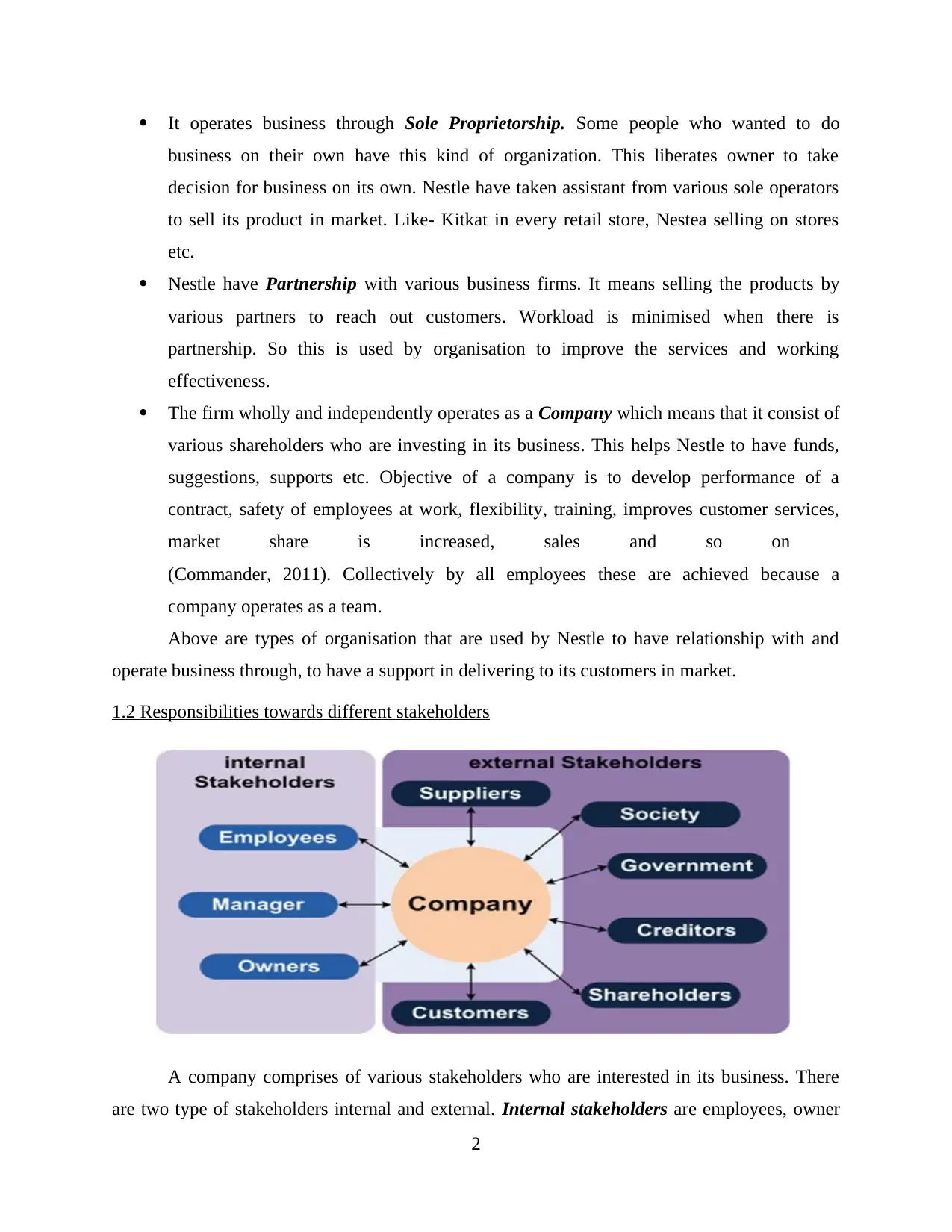
It operates business through Sole Proprietorship. Some people who wanted to do
business on their own have this kind of organization. This liberates owner to take
decision for business on its own. Nestle have taken assistant from various sole operators
to sell its product in market. Like- Kitkat in every retail store, Nestea selling on stores
etc.
Nestle have Partnership with various business firms. It means selling the products by
various partners to reach out customers. Workload is minimised when there is
partnership. So this is used by organisation to improve the services and working
effectiveness.
The firm wholly and independently operates as a Company which means that it consist of
various shareholders who are investing in its business. This helps Nestle to have funds,
suggestions, supports etc. Objective of a company is to develop performance of a
contract, safety of employees at work, flexibility, training, improves customer services,
market share is increased, sales and so on
(Commander, 2011). Collectively by all employees these are achieved because a
company operates as a team.
Above are types of organisation that are used by Nestle to have relationship with and
operate business through, to have a support in delivering to its customers in market.
1.2 Responsibilities towards different stakeholders
A company comprises of various stakeholders who are interested in its business. There
are two type of stakeholders internal and external. Internal stakeholders are employees, owner
2
business on their own have this kind of organization. This liberates owner to take
decision for business on its own. Nestle have taken assistant from various sole operators
to sell its product in market. Like- Kitkat in every retail store, Nestea selling on stores
etc.
Nestle have Partnership with various business firms. It means selling the products by
various partners to reach out customers. Workload is minimised when there is
partnership. So this is used by organisation to improve the services and working
effectiveness.
The firm wholly and independently operates as a Company which means that it consist of
various shareholders who are investing in its business. This helps Nestle to have funds,
suggestions, supports etc. Objective of a company is to develop performance of a
contract, safety of employees at work, flexibility, training, improves customer services,
market share is increased, sales and so on
(Commander, 2011). Collectively by all employees these are achieved because a
company operates as a team.
Above are types of organisation that are used by Nestle to have relationship with and
operate business through, to have a support in delivering to its customers in market.
1.2 Responsibilities towards different stakeholders
A company comprises of various stakeholders who are interested in its business. There
are two type of stakeholders internal and external. Internal stakeholders are employees, owner
2
Secure Best Marks with AI Grader
Need help grading? Try our AI Grader for instant feedback on your assignments.
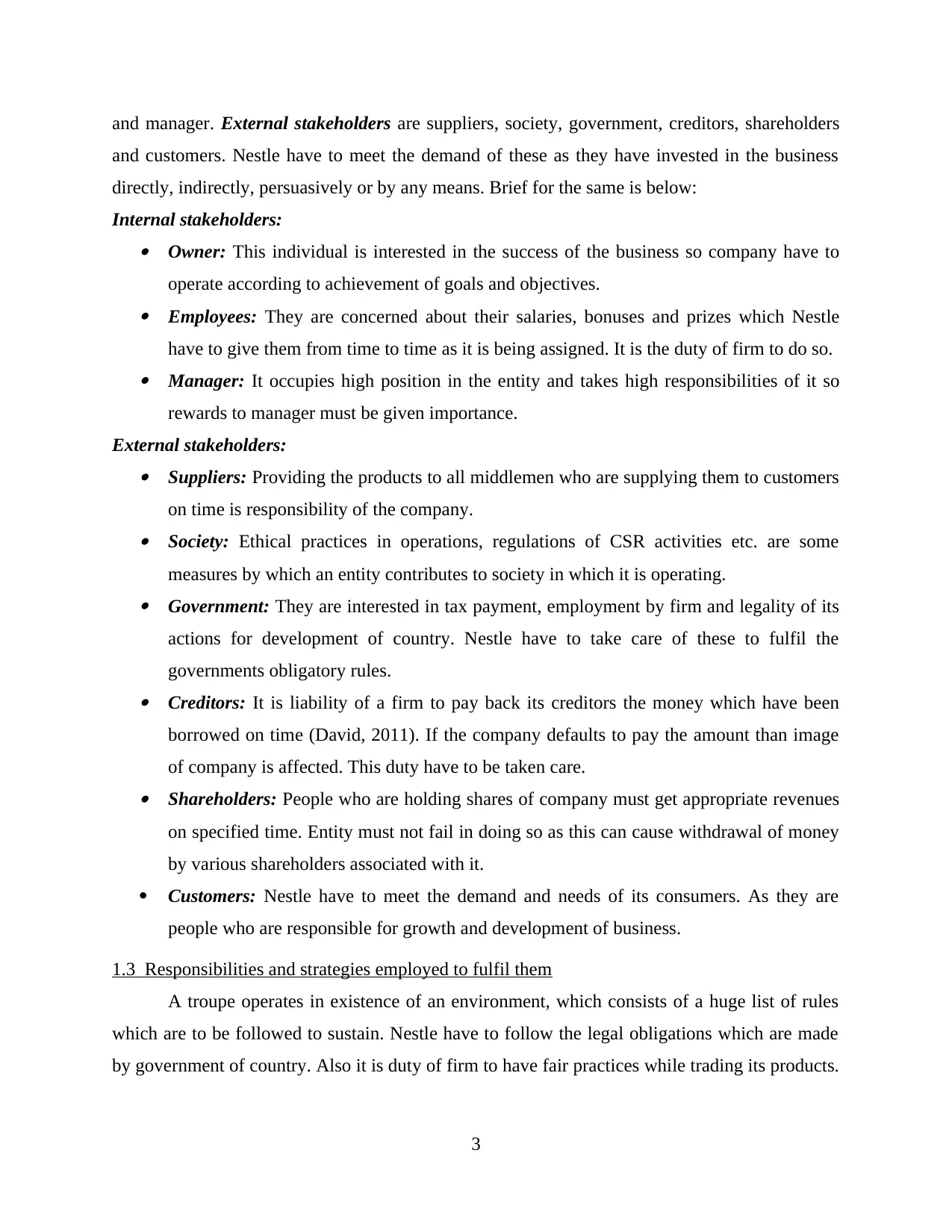
and manager. External stakeholders are suppliers, society, government, creditors, shareholders
and customers. Nestle have to meet the demand of these as they have invested in the business
directly, indirectly, persuasively or by any means. Brief for the same is below:
Internal stakeholders: Owner: This individual is interested in the success of the business so company have to
operate according to achievement of goals and objectives. Employees: They are concerned about their salaries, bonuses and prizes which Nestle
have to give them from time to time as it is being assigned. It is the duty of firm to do so. Manager: It occupies high position in the entity and takes high responsibilities of it so
rewards to manager must be given importance.
External stakeholders: Suppliers: Providing the products to all middlemen who are supplying them to customers
on time is responsibility of the company. Society: Ethical practices in operations, regulations of CSR activities etc. are some
measures by which an entity contributes to society in which it is operating. Government: They are interested in tax payment, employment by firm and legality of its
actions for development of country. Nestle have to take care of these to fulfil the
governments obligatory rules. Creditors: It is liability of a firm to pay back its creditors the money which have been
borrowed on time (David, 2011). If the company defaults to pay the amount than image
of company is affected. This duty have to be taken care. Shareholders: People who are holding shares of company must get appropriate revenues
on specified time. Entity must not fail in doing so as this can cause withdrawal of money
by various shareholders associated with it.
Customers: Nestle have to meet the demand and needs of its consumers. As they are
people who are responsible for growth and development of business.
1.3 Responsibilities and strategies employed to fulfil them
A troupe operates in existence of an environment, which consists of a huge list of rules
which are to be followed to sustain. Nestle have to follow the legal obligations which are made
by government of country. Also it is duty of firm to have fair practices while trading its products.
3
and customers. Nestle have to meet the demand of these as they have invested in the business
directly, indirectly, persuasively or by any means. Brief for the same is below:
Internal stakeholders: Owner: This individual is interested in the success of the business so company have to
operate according to achievement of goals and objectives. Employees: They are concerned about their salaries, bonuses and prizes which Nestle
have to give them from time to time as it is being assigned. It is the duty of firm to do so. Manager: It occupies high position in the entity and takes high responsibilities of it so
rewards to manager must be given importance.
External stakeholders: Suppliers: Providing the products to all middlemen who are supplying them to customers
on time is responsibility of the company. Society: Ethical practices in operations, regulations of CSR activities etc. are some
measures by which an entity contributes to society in which it is operating. Government: They are interested in tax payment, employment by firm and legality of its
actions for development of country. Nestle have to take care of these to fulfil the
governments obligatory rules. Creditors: It is liability of a firm to pay back its creditors the money which have been
borrowed on time (David, 2011). If the company defaults to pay the amount than image
of company is affected. This duty have to be taken care. Shareholders: People who are holding shares of company must get appropriate revenues
on specified time. Entity must not fail in doing so as this can cause withdrawal of money
by various shareholders associated with it.
Customers: Nestle have to meet the demand and needs of its consumers. As they are
people who are responsible for growth and development of business.
1.3 Responsibilities and strategies employed to fulfil them
A troupe operates in existence of an environment, which consists of a huge list of rules
which are to be followed to sustain. Nestle have to follow the legal obligations which are made
by government of country. Also it is duty of firm to have fair practices while trading its products.
3
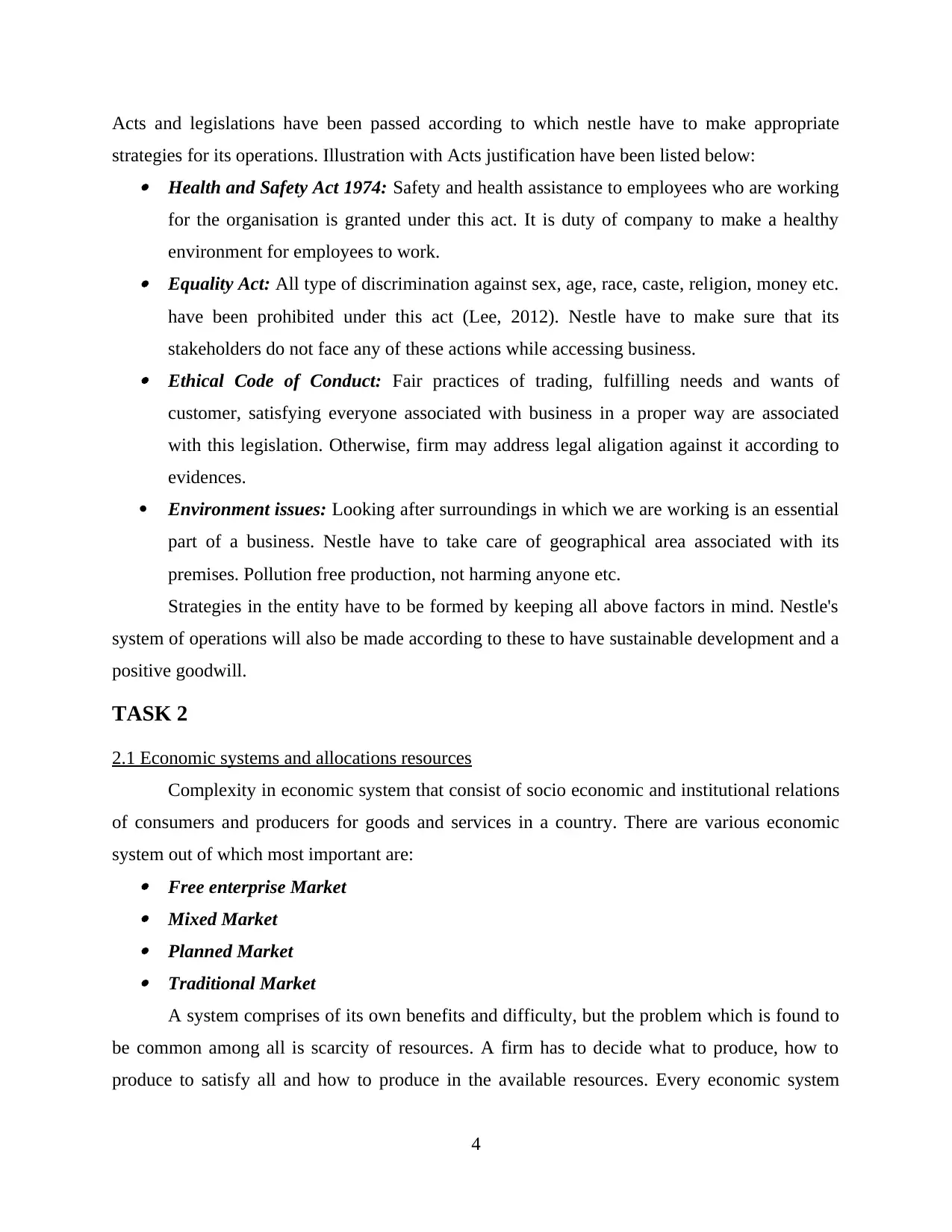
Acts and legislations have been passed according to which nestle have to make appropriate
strategies for its operations. Illustration with Acts justification have been listed below: Health and Safety Act 1974: Safety and health assistance to employees who are working
for the organisation is granted under this act. It is duty of company to make a healthy
environment for employees to work. Equality Act: All type of discrimination against sex, age, race, caste, religion, money etc.
have been prohibited under this act (Lee, 2012). Nestle have to make sure that its
stakeholders do not face any of these actions while accessing business. Ethical Code of Conduct: Fair practices of trading, fulfilling needs and wants of
customer, satisfying everyone associated with business in a proper way are associated
with this legislation. Otherwise, firm may address legal aligation against it according to
evidences.
Environment issues: Looking after surroundings in which we are working is an essential
part of a business. Nestle have to take care of geographical area associated with its
premises. Pollution free production, not harming anyone etc.
Strategies in the entity have to be formed by keeping all above factors in mind. Nestle's
system of operations will also be made according to these to have sustainable development and a
positive goodwill.
TASK 2
2.1 Economic systems and allocations resources
Complexity in economic system that consist of socio economic and institutional relations
of consumers and producers for goods and services in a country. There are various economic
system out of which most important are: Free enterprise Market Mixed Market Planned Market Traditional Market
A system comprises of its own benefits and difficulty, but the problem which is found to
be common among all is scarcity of resources. A firm has to decide what to produce, how to
produce to satisfy all and how to produce in the available resources. Every economic system
4
strategies for its operations. Illustration with Acts justification have been listed below: Health and Safety Act 1974: Safety and health assistance to employees who are working
for the organisation is granted under this act. It is duty of company to make a healthy
environment for employees to work. Equality Act: All type of discrimination against sex, age, race, caste, religion, money etc.
have been prohibited under this act (Lee, 2012). Nestle have to make sure that its
stakeholders do not face any of these actions while accessing business. Ethical Code of Conduct: Fair practices of trading, fulfilling needs and wants of
customer, satisfying everyone associated with business in a proper way are associated
with this legislation. Otherwise, firm may address legal aligation against it according to
evidences.
Environment issues: Looking after surroundings in which we are working is an essential
part of a business. Nestle have to take care of geographical area associated with its
premises. Pollution free production, not harming anyone etc.
Strategies in the entity have to be formed by keeping all above factors in mind. Nestle's
system of operations will also be made according to these to have sustainable development and a
positive goodwill.
TASK 2
2.1 Economic systems and allocations resources
Complexity in economic system that consist of socio economic and institutional relations
of consumers and producers for goods and services in a country. There are various economic
system out of which most important are: Free enterprise Market Mixed Market Planned Market Traditional Market
A system comprises of its own benefits and difficulty, but the problem which is found to
be common among all is scarcity of resources. A firm has to decide what to produce, how to
produce to satisfy all and how to produce in the available resources. Every economic system
4
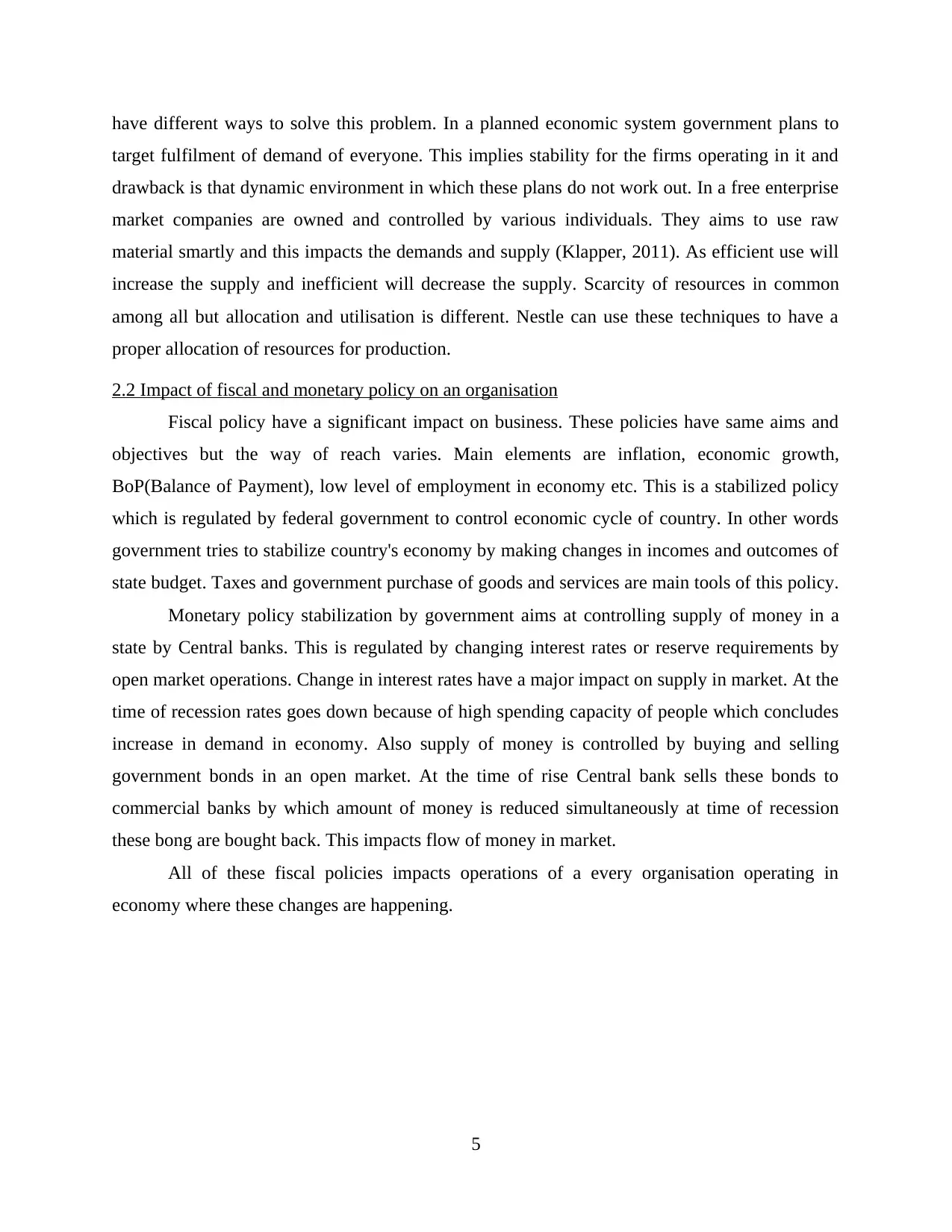
have different ways to solve this problem. In a planned economic system government plans to
target fulfilment of demand of everyone. This implies stability for the firms operating in it and
drawback is that dynamic environment in which these plans do not work out. In a free enterprise
market companies are owned and controlled by various individuals. They aims to use raw
material smartly and this impacts the demands and supply (Klapper, 2011). As efficient use will
increase the supply and inefficient will decrease the supply. Scarcity of resources in common
among all but allocation and utilisation is different. Nestle can use these techniques to have a
proper allocation of resources for production.
2.2 Impact of fiscal and monetary policy on an organisation
Fiscal policy have a significant impact on business. These policies have same aims and
objectives but the way of reach varies. Main elements are inflation, economic growth,
BoP(Balance of Payment), low level of employment in economy etc. This is a stabilized policy
which is regulated by federal government to control economic cycle of country. In other words
government tries to stabilize country's economy by making changes in incomes and outcomes of
state budget. Taxes and government purchase of goods and services are main tools of this policy.
Monetary policy stabilization by government aims at controlling supply of money in a
state by Central banks. This is regulated by changing interest rates or reserve requirements by
open market operations. Change in interest rates have a major impact on supply in market. At the
time of recession rates goes down because of high spending capacity of people which concludes
increase in demand in economy. Also supply of money is controlled by buying and selling
government bonds in an open market. At the time of rise Central bank sells these bonds to
commercial banks by which amount of money is reduced simultaneously at time of recession
these bong are bought back. This impacts flow of money in market.
All of these fiscal policies impacts operations of a every organisation operating in
economy where these changes are happening.
5
target fulfilment of demand of everyone. This implies stability for the firms operating in it and
drawback is that dynamic environment in which these plans do not work out. In a free enterprise
market companies are owned and controlled by various individuals. They aims to use raw
material smartly and this impacts the demands and supply (Klapper, 2011). As efficient use will
increase the supply and inefficient will decrease the supply. Scarcity of resources in common
among all but allocation and utilisation is different. Nestle can use these techniques to have a
proper allocation of resources for production.
2.2 Impact of fiscal and monetary policy on an organisation
Fiscal policy have a significant impact on business. These policies have same aims and
objectives but the way of reach varies. Main elements are inflation, economic growth,
BoP(Balance of Payment), low level of employment in economy etc. This is a stabilized policy
which is regulated by federal government to control economic cycle of country. In other words
government tries to stabilize country's economy by making changes in incomes and outcomes of
state budget. Taxes and government purchase of goods and services are main tools of this policy.
Monetary policy stabilization by government aims at controlling supply of money in a
state by Central banks. This is regulated by changing interest rates or reserve requirements by
open market operations. Change in interest rates have a major impact on supply in market. At the
time of recession rates goes down because of high spending capacity of people which concludes
increase in demand in economy. Also supply of money is controlled by buying and selling
government bonds in an open market. At the time of rise Central bank sells these bonds to
commercial banks by which amount of money is reduced simultaneously at time of recession
these bong are bought back. This impacts flow of money in market.
All of these fiscal policies impacts operations of a every organisation operating in
economy where these changes are happening.
5
Paraphrase This Document
Need a fresh take? Get an instant paraphrase of this document with our AI Paraphraser
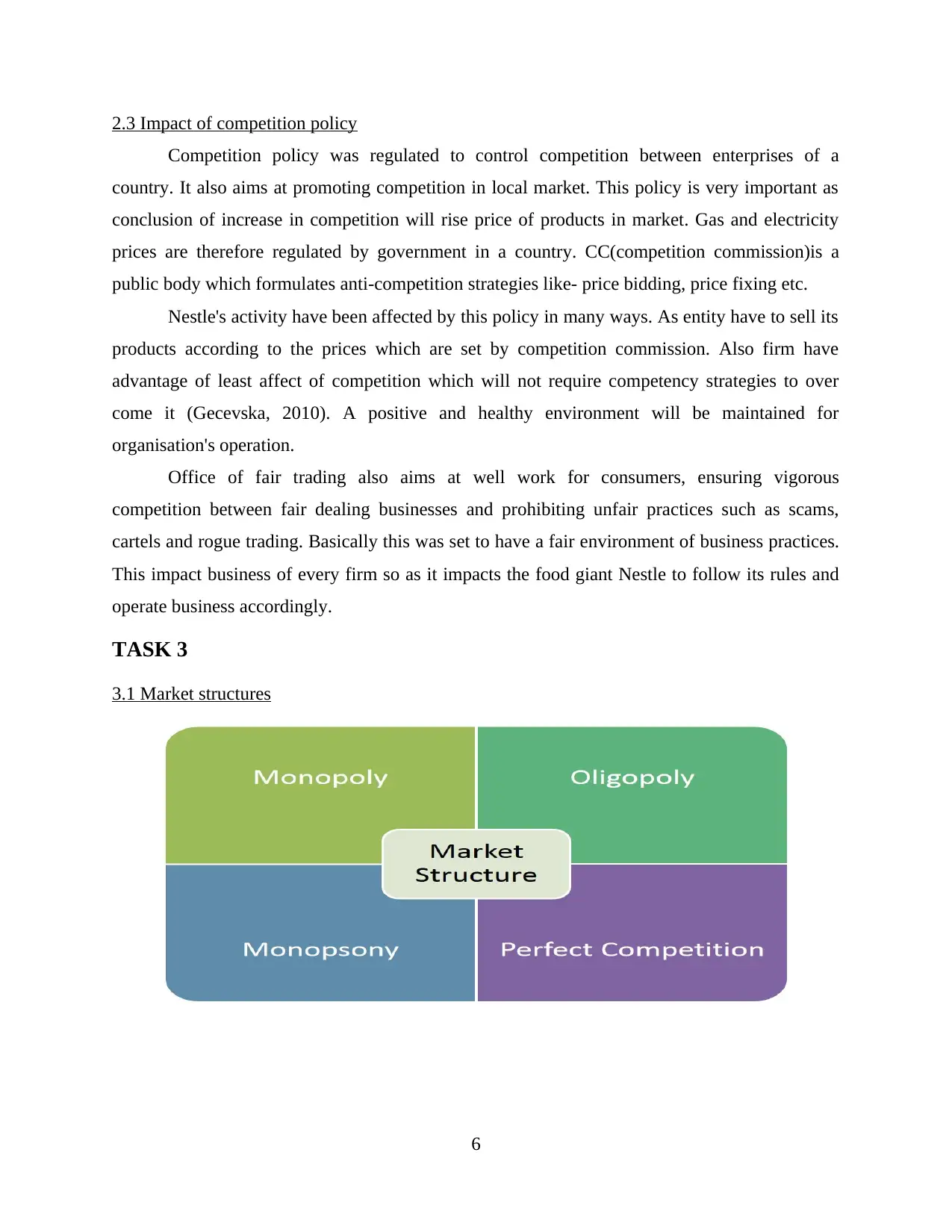
2.3 Impact of competition policy
Competition policy was regulated to control competition between enterprises of a
country. It also aims at promoting competition in local market. This policy is very important as
conclusion of increase in competition will rise price of products in market. Gas and electricity
prices are therefore regulated by government in a country. CC(competition commission)is a
public body which formulates anti-competition strategies like- price bidding, price fixing etc.
Nestle's activity have been affected by this policy in many ways. As entity have to sell its
products according to the prices which are set by competition commission. Also firm have
advantage of least affect of competition which will not require competency strategies to over
come it (Gecevska, 2010). A positive and healthy environment will be maintained for
organisation's operation.
Office of fair trading also aims at well work for consumers, ensuring vigorous
competition between fair dealing businesses and prohibiting unfair practices such as scams,
cartels and rogue trading. Basically this was set to have a fair environment of business practices.
This impact business of every firm so as it impacts the food giant Nestle to follow its rules and
operate business accordingly.
TASK 3
3.1 Market structures
6
Competition policy was regulated to control competition between enterprises of a
country. It also aims at promoting competition in local market. This policy is very important as
conclusion of increase in competition will rise price of products in market. Gas and electricity
prices are therefore regulated by government in a country. CC(competition commission)is a
public body which formulates anti-competition strategies like- price bidding, price fixing etc.
Nestle's activity have been affected by this policy in many ways. As entity have to sell its
products according to the prices which are set by competition commission. Also firm have
advantage of least affect of competition which will not require competency strategies to over
come it (Gecevska, 2010). A positive and healthy environment will be maintained for
organisation's operation.
Office of fair trading also aims at well work for consumers, ensuring vigorous
competition between fair dealing businesses and prohibiting unfair practices such as scams,
cartels and rogue trading. Basically this was set to have a fair environment of business practices.
This impact business of every firm so as it impacts the food giant Nestle to follow its rules and
operate business accordingly.
TASK 3
3.1 Market structures
6
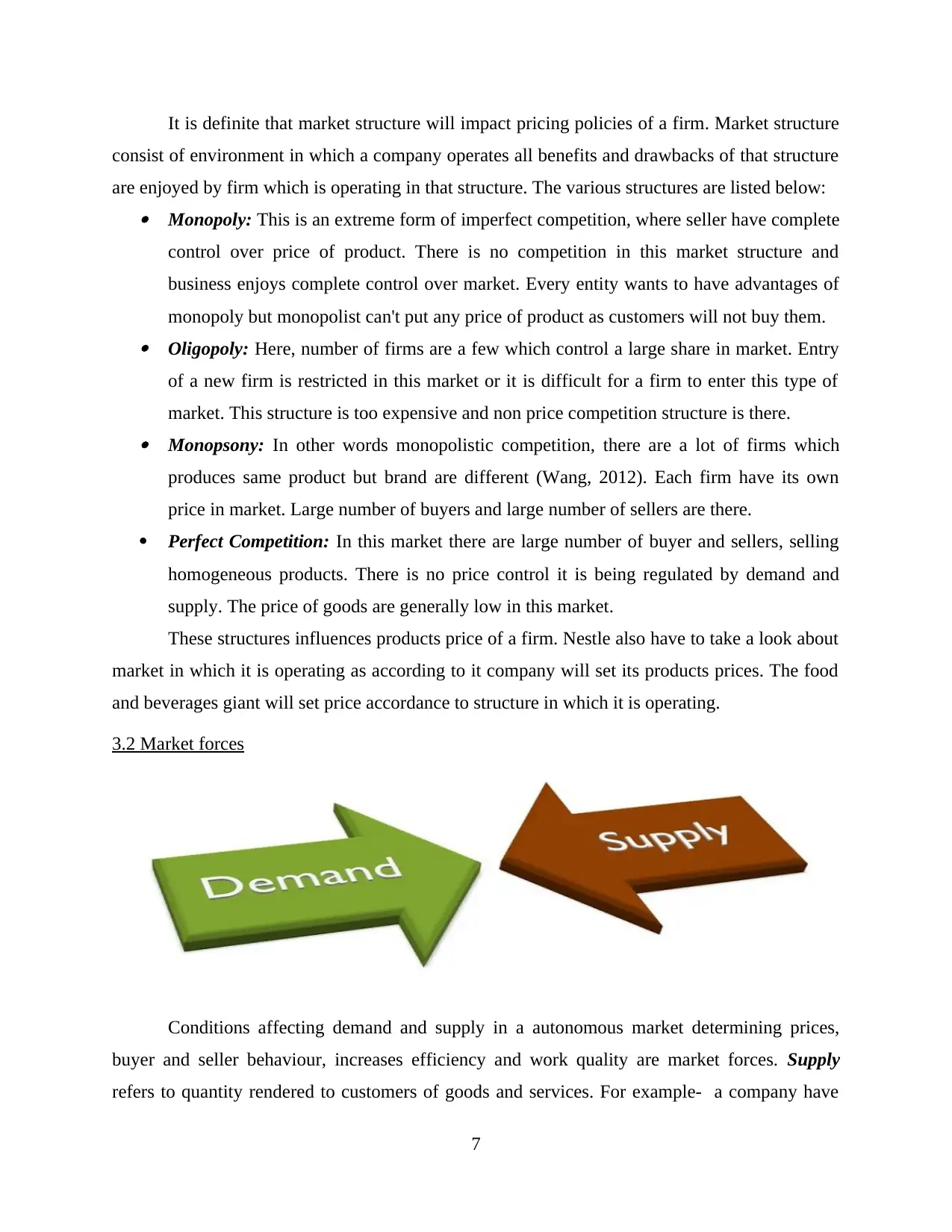
It is definite that market structure will impact pricing policies of a firm. Market structure
consist of environment in which a company operates all benefits and drawbacks of that structure
are enjoyed by firm which is operating in that structure. The various structures are listed below: Monopoly: This is an extreme form of imperfect competition, where seller have complete
control over price of product. There is no competition in this market structure and
business enjoys complete control over market. Every entity wants to have advantages of
monopoly but monopolist can't put any price of product as customers will not buy them. Oligopoly: Here, number of firms are a few which control a large share in market. Entry
of a new firm is restricted in this market or it is difficult for a firm to enter this type of
market. This structure is too expensive and non price competition structure is there. Monopsony: In other words monopolistic competition, there are a lot of firms which
produces same product but brand are different (Wang, 2012). Each firm have its own
price in market. Large number of buyers and large number of sellers are there.
Perfect Competition: In this market there are large number of buyer and sellers, selling
homogeneous products. There is no price control it is being regulated by demand and
supply. The price of goods are generally low in this market.
These structures influences products price of a firm. Nestle also have to take a look about
market in which it is operating as according to it company will set its products prices. The food
and beverages giant will set price accordance to structure in which it is operating.
3.2 Market forces
Conditions affecting demand and supply in a autonomous market determining prices,
buyer and seller behaviour, increases efficiency and work quality are market forces. Supply
refers to quantity rendered to customers of goods and services. For example- a company have
7
consist of environment in which a company operates all benefits and drawbacks of that structure
are enjoyed by firm which is operating in that structure. The various structures are listed below: Monopoly: This is an extreme form of imperfect competition, where seller have complete
control over price of product. There is no competition in this market structure and
business enjoys complete control over market. Every entity wants to have advantages of
monopoly but monopolist can't put any price of product as customers will not buy them. Oligopoly: Here, number of firms are a few which control a large share in market. Entry
of a new firm is restricted in this market or it is difficult for a firm to enter this type of
market. This structure is too expensive and non price competition structure is there. Monopsony: In other words monopolistic competition, there are a lot of firms which
produces same product but brand are different (Wang, 2012). Each firm have its own
price in market. Large number of buyers and large number of sellers are there.
Perfect Competition: In this market there are large number of buyer and sellers, selling
homogeneous products. There is no price control it is being regulated by demand and
supply. The price of goods are generally low in this market.
These structures influences products price of a firm. Nestle also have to take a look about
market in which it is operating as according to it company will set its products prices. The food
and beverages giant will set price accordance to structure in which it is operating.
3.2 Market forces
Conditions affecting demand and supply in a autonomous market determining prices,
buyer and seller behaviour, increases efficiency and work quality are market forces. Supply
refers to quantity rendered to customers of goods and services. For example- a company have
7
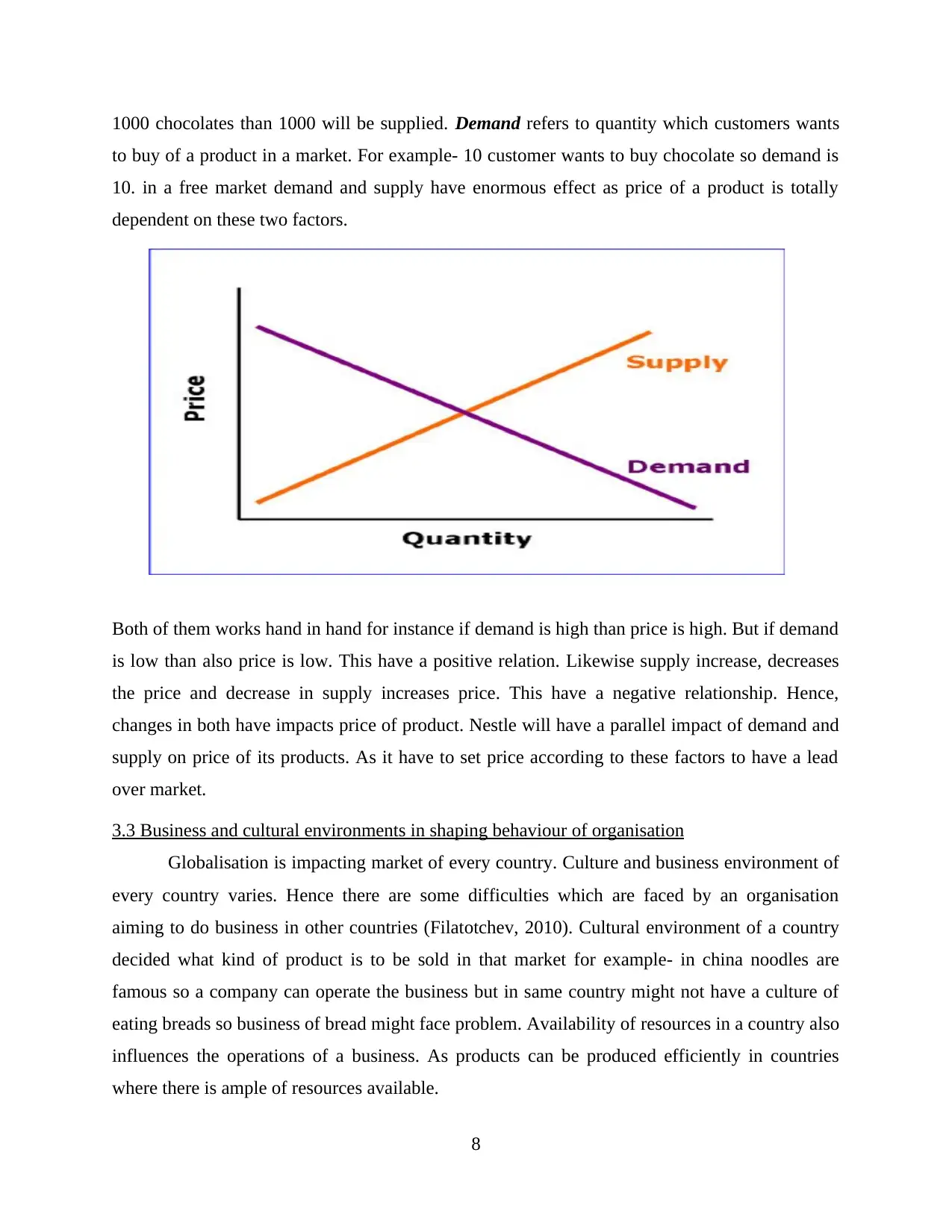
1000 chocolates than 1000 will be supplied. Demand refers to quantity which customers wants
to buy of a product in a market. For example- 10 customer wants to buy chocolate so demand is
10. in a free market demand and supply have enormous effect as price of a product is totally
dependent on these two factors.
Both of them works hand in hand for instance if demand is high than price is high. But if demand
is low than also price is low. This have a positive relation. Likewise supply increase, decreases
the price and decrease in supply increases price. This have a negative relationship. Hence,
changes in both have impacts price of product. Nestle will have a parallel impact of demand and
supply on price of its products. As it have to set price according to these factors to have a lead
over market.
3.3 Business and cultural environments in shaping behaviour of organisation
Globalisation is impacting market of every country. Culture and business environment of
every country varies. Hence there are some difficulties which are faced by an organisation
aiming to do business in other countries (Filatotchev, 2010). Cultural environment of a country
decided what kind of product is to be sold in that market for example- in china noodles are
famous so a company can operate the business but in same country might not have a culture of
eating breads so business of bread might face problem. Availability of resources in a country also
influences the operations of a business. As products can be produced efficiently in countries
where there is ample of resources available.
8
to buy of a product in a market. For example- 10 customer wants to buy chocolate so demand is
10. in a free market demand and supply have enormous effect as price of a product is totally
dependent on these two factors.
Both of them works hand in hand for instance if demand is high than price is high. But if demand
is low than also price is low. This have a positive relation. Likewise supply increase, decreases
the price and decrease in supply increases price. This have a negative relationship. Hence,
changes in both have impacts price of product. Nestle will have a parallel impact of demand and
supply on price of its products. As it have to set price according to these factors to have a lead
over market.
3.3 Business and cultural environments in shaping behaviour of organisation
Globalisation is impacting market of every country. Culture and business environment of
every country varies. Hence there are some difficulties which are faced by an organisation
aiming to do business in other countries (Filatotchev, 2010). Cultural environment of a country
decided what kind of product is to be sold in that market for example- in china noodles are
famous so a company can operate the business but in same country might not have a culture of
eating breads so business of bread might face problem. Availability of resources in a country also
influences the operations of a business. As products can be produced efficiently in countries
where there is ample of resources available.
8
Secure Best Marks with AI Grader
Need help grading? Try our AI Grader for instant feedback on your assignments.
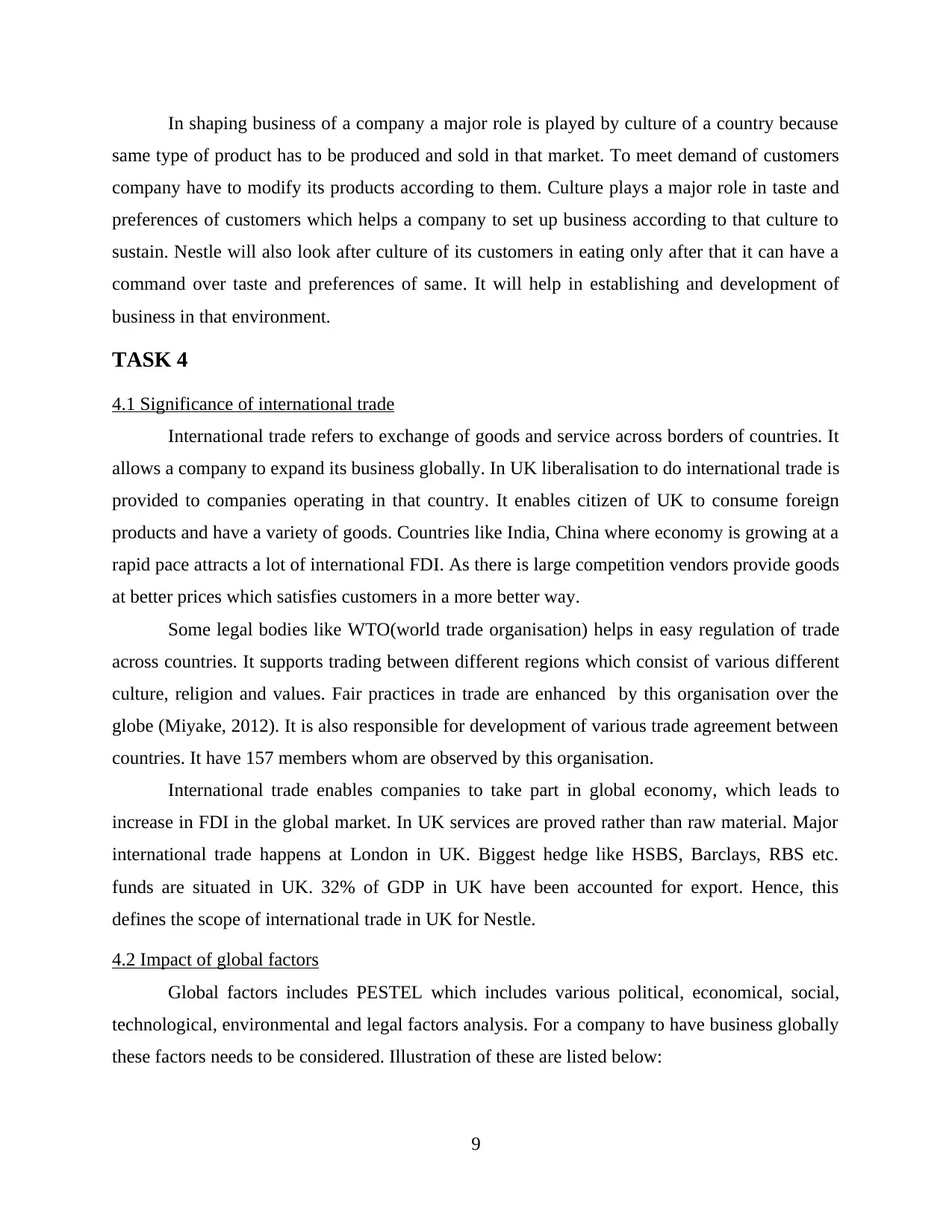
In shaping business of a company a major role is played by culture of a country because
same type of product has to be produced and sold in that market. To meet demand of customers
company have to modify its products according to them. Culture plays a major role in taste and
preferences of customers which helps a company to set up business according to that culture to
sustain. Nestle will also look after culture of its customers in eating only after that it can have a
command over taste and preferences of same. It will help in establishing and development of
business in that environment.
TASK 4
4.1 Significance of international trade
International trade refers to exchange of goods and service across borders of countries. It
allows a company to expand its business globally. In UK liberalisation to do international trade is
provided to companies operating in that country. It enables citizen of UK to consume foreign
products and have a variety of goods. Countries like India, China where economy is growing at a
rapid pace attracts a lot of international FDI. As there is large competition vendors provide goods
at better prices which satisfies customers in a more better way.
Some legal bodies like WTO(world trade organisation) helps in easy regulation of trade
across countries. It supports trading between different regions which consist of various different
culture, religion and values. Fair practices in trade are enhanced by this organisation over the
globe (Miyake, 2012). It is also responsible for development of various trade agreement between
countries. It have 157 members whom are observed by this organisation.
International trade enables companies to take part in global economy, which leads to
increase in FDI in the global market. In UK services are proved rather than raw material. Major
international trade happens at London in UK. Biggest hedge like HSBS, Barclays, RBS etc.
funds are situated in UK. 32% of GDP in UK have been accounted for export. Hence, this
defines the scope of international trade in UK for Nestle.
4.2 Impact of global factors
Global factors includes PESTEL which includes various political, economical, social,
technological, environmental and legal factors analysis. For a company to have business globally
these factors needs to be considered. Illustration of these are listed below:
9
same type of product has to be produced and sold in that market. To meet demand of customers
company have to modify its products according to them. Culture plays a major role in taste and
preferences of customers which helps a company to set up business according to that culture to
sustain. Nestle will also look after culture of its customers in eating only after that it can have a
command over taste and preferences of same. It will help in establishing and development of
business in that environment.
TASK 4
4.1 Significance of international trade
International trade refers to exchange of goods and service across borders of countries. It
allows a company to expand its business globally. In UK liberalisation to do international trade is
provided to companies operating in that country. It enables citizen of UK to consume foreign
products and have a variety of goods. Countries like India, China where economy is growing at a
rapid pace attracts a lot of international FDI. As there is large competition vendors provide goods
at better prices which satisfies customers in a more better way.
Some legal bodies like WTO(world trade organisation) helps in easy regulation of trade
across countries. It supports trading between different regions which consist of various different
culture, religion and values. Fair practices in trade are enhanced by this organisation over the
globe (Miyake, 2012). It is also responsible for development of various trade agreement between
countries. It have 157 members whom are observed by this organisation.
International trade enables companies to take part in global economy, which leads to
increase in FDI in the global market. In UK services are proved rather than raw material. Major
international trade happens at London in UK. Biggest hedge like HSBS, Barclays, RBS etc.
funds are situated in UK. 32% of GDP in UK have been accounted for export. Hence, this
defines the scope of international trade in UK for Nestle.
4.2 Impact of global factors
Global factors includes PESTEL which includes various political, economical, social,
technological, environmental and legal factors analysis. For a company to have business globally
these factors needs to be considered. Illustration of these are listed below:
9
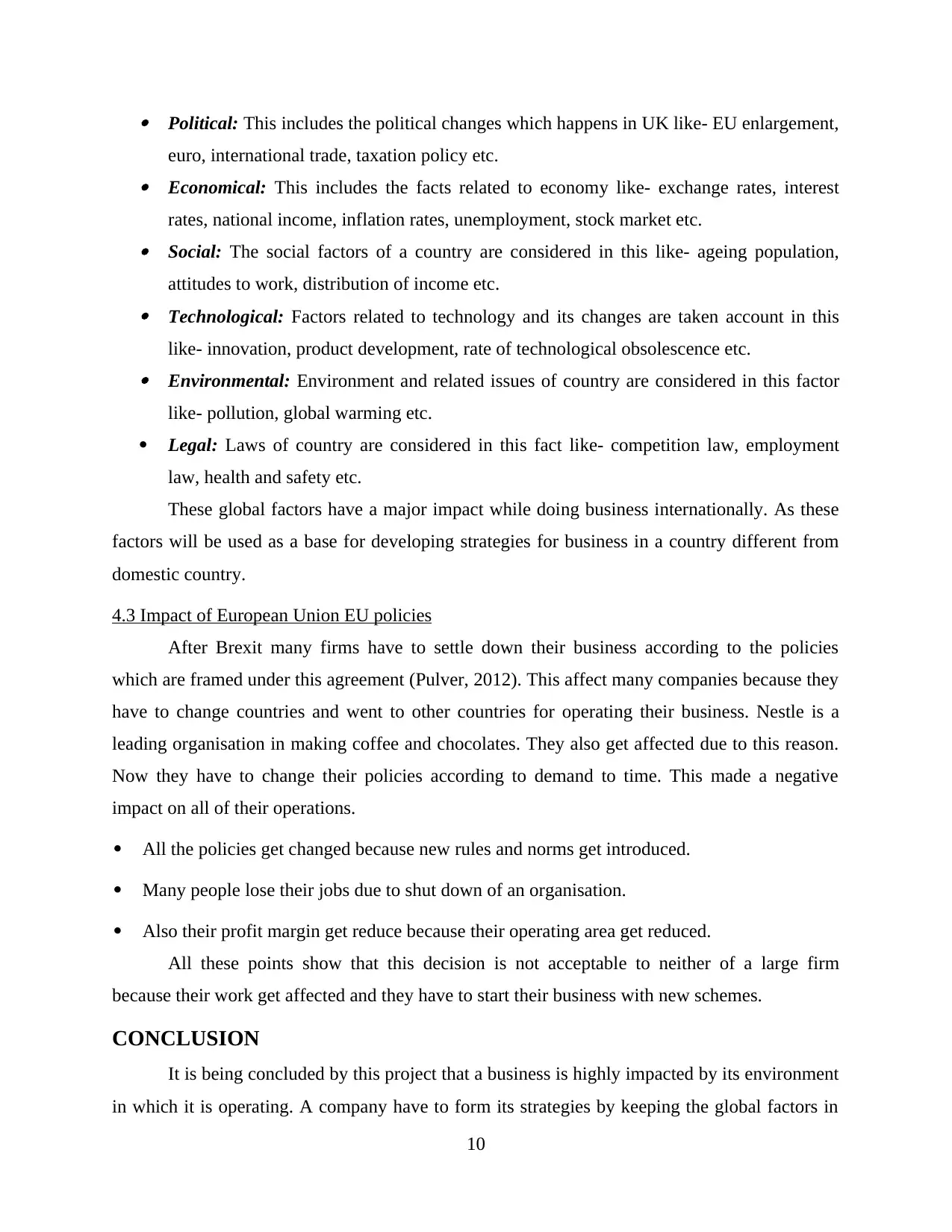
Political: This includes the political changes which happens in UK like- EU enlargement,
euro, international trade, taxation policy etc. Economical: This includes the facts related to economy like- exchange rates, interest
rates, national income, inflation rates, unemployment, stock market etc. Social: The social factors of a country are considered in this like- ageing population,
attitudes to work, distribution of income etc. Technological: Factors related to technology and its changes are taken account in this
like- innovation, product development, rate of technological obsolescence etc. Environmental: Environment and related issues of country are considered in this factor
like- pollution, global warming etc.
Legal: Laws of country are considered in this fact like- competition law, employment
law, health and safety etc.
These global factors have a major impact while doing business internationally. As these
factors will be used as a base for developing strategies for business in a country different from
domestic country.
4.3 Impact of European Union EU policies
After Brexit many firms have to settle down their business according to the policies
which are framed under this agreement (Pulver, 2012). This affect many companies because they
have to change countries and went to other countries for operating their business. Nestle is a
leading organisation in making coffee and chocolates. They also get affected due to this reason.
Now they have to change their policies according to demand to time. This made a negative
impact on all of their operations.
All the policies get changed because new rules and norms get introduced.
Many people lose their jobs due to shut down of an organisation.
Also their profit margin get reduce because their operating area get reduced.
All these points show that this decision is not acceptable to neither of a large firm
because their work get affected and they have to start their business with new schemes.
CONCLUSION
It is being concluded by this project that a business is highly impacted by its environment
in which it is operating. A company have to form its strategies by keeping the global factors in
10
euro, international trade, taxation policy etc. Economical: This includes the facts related to economy like- exchange rates, interest
rates, national income, inflation rates, unemployment, stock market etc. Social: The social factors of a country are considered in this like- ageing population,
attitudes to work, distribution of income etc. Technological: Factors related to technology and its changes are taken account in this
like- innovation, product development, rate of technological obsolescence etc. Environmental: Environment and related issues of country are considered in this factor
like- pollution, global warming etc.
Legal: Laws of country are considered in this fact like- competition law, employment
law, health and safety etc.
These global factors have a major impact while doing business internationally. As these
factors will be used as a base for developing strategies for business in a country different from
domestic country.
4.3 Impact of European Union EU policies
After Brexit many firms have to settle down their business according to the policies
which are framed under this agreement (Pulver, 2012). This affect many companies because they
have to change countries and went to other countries for operating their business. Nestle is a
leading organisation in making coffee and chocolates. They also get affected due to this reason.
Now they have to change their policies according to demand to time. This made a negative
impact on all of their operations.
All the policies get changed because new rules and norms get introduced.
Many people lose their jobs due to shut down of an organisation.
Also their profit margin get reduce because their operating area get reduced.
All these points show that this decision is not acceptable to neither of a large firm
because their work get affected and they have to start their business with new schemes.
CONCLUSION
It is being concluded by this project that a business is highly impacted by its environment
in which it is operating. A company have to form its strategies by keeping the global factors in
10
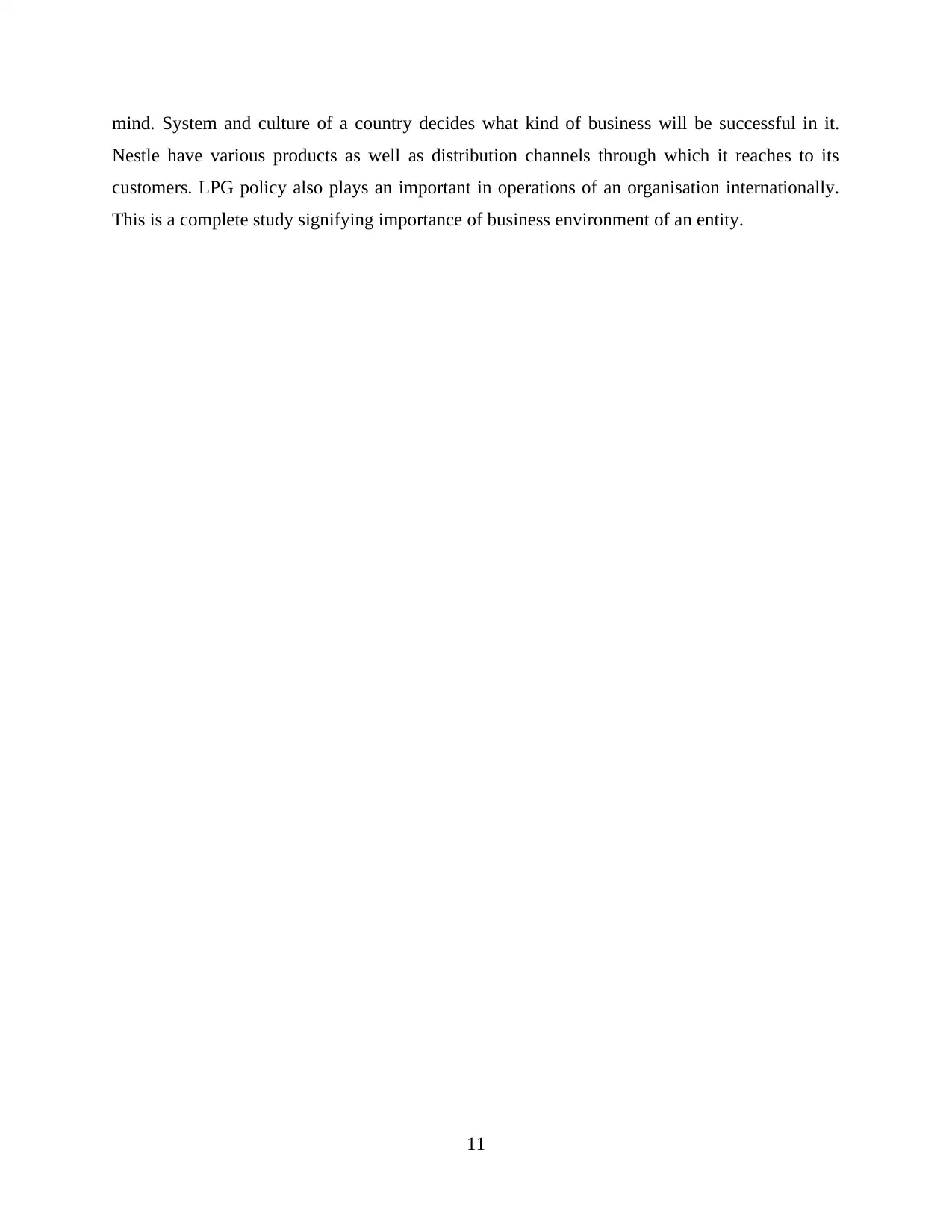
mind. System and culture of a country decides what kind of business will be successful in it.
Nestle have various products as well as distribution channels through which it reaches to its
customers. LPG policy also plays an important in operations of an organisation internationally.
This is a complete study signifying importance of business environment of an entity.
11
Nestle have various products as well as distribution channels through which it reaches to its
customers. LPG policy also plays an important in operations of an organisation internationally.
This is a complete study signifying importance of business environment of an entity.
11
Paraphrase This Document
Need a fresh take? Get an instant paraphrase of this document with our AI Paraphraser
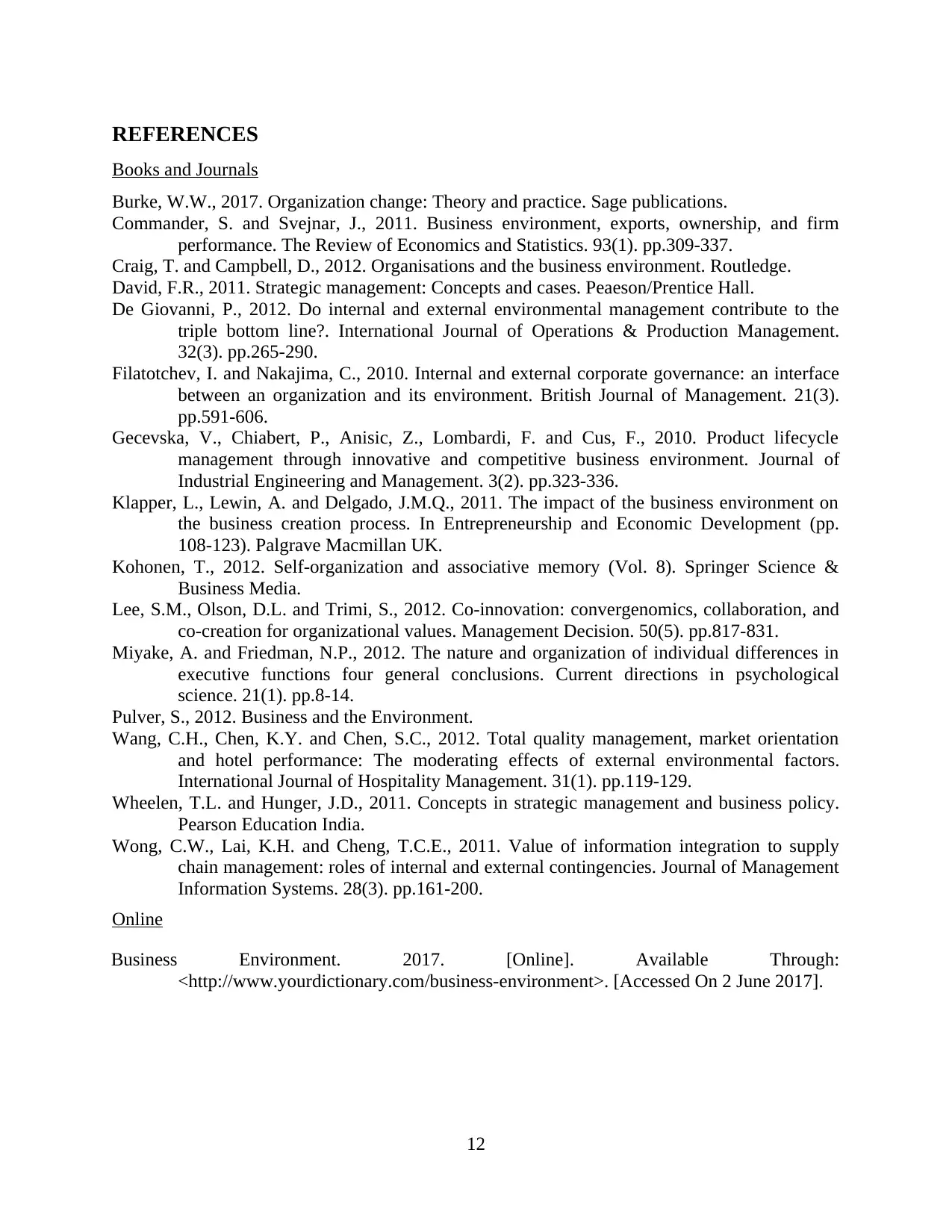
REFERENCES
Books and Journals
Burke, W.W., 2017. Organization change: Theory and practice. Sage publications.
Commander, S. and Svejnar, J., 2011. Business environment, exports, ownership, and firm
performance. The Review of Economics and Statistics. 93(1). pp.309-337.
Craig, T. and Campbell, D., 2012. Organisations and the business environment. Routledge.
David, F.R., 2011. Strategic management: Concepts and cases. Peaeson/Prentice Hall.
De Giovanni, P., 2012. Do internal and external environmental management contribute to the
triple bottom line?. International Journal of Operations & Production Management.
32(3). pp.265-290.
Filatotchev, I. and Nakajima, C., 2010. Internal and external corporate governance: an interface
between an organization and its environment. British Journal of Management. 21(3).
pp.591-606.
Gecevska, V., Chiabert, P., Anisic, Z., Lombardi, F. and Cus, F., 2010. Product lifecycle
management through innovative and competitive business environment. Journal of
Industrial Engineering and Management. 3(2). pp.323-336.
Klapper, L., Lewin, A. and Delgado, J.M.Q., 2011. The impact of the business environment on
the business creation process. In Entrepreneurship and Economic Development (pp.
108-123). Palgrave Macmillan UK.
Kohonen, T., 2012. Self-organization and associative memory (Vol. 8). Springer Science &
Business Media.
Lee, S.M., Olson, D.L. and Trimi, S., 2012. Co-innovation: convergenomics, collaboration, and
co-creation for organizational values. Management Decision. 50(5). pp.817-831.
Miyake, A. and Friedman, N.P., 2012. The nature and organization of individual differences in
executive functions four general conclusions. Current directions in psychological
science. 21(1). pp.8-14.
Pulver, S., 2012. Business and the Environment.
Wang, C.H., Chen, K.Y. and Chen, S.C., 2012. Total quality management, market orientation
and hotel performance: The moderating effects of external environmental factors.
International Journal of Hospitality Management. 31(1). pp.119-129.
Wheelen, T.L. and Hunger, J.D., 2011. Concepts in strategic management and business policy.
Pearson Education India.
Wong, C.W., Lai, K.H. and Cheng, T.C.E., 2011. Value of information integration to supply
chain management: roles of internal and external contingencies. Journal of Management
Information Systems. 28(3). pp.161-200.
Online
Business Environment. 2017. [Online]. Available Through:
<http://www.yourdictionary.com/business-environment>. [Accessed On 2 June 2017].
12
Books and Journals
Burke, W.W., 2017. Organization change: Theory and practice. Sage publications.
Commander, S. and Svejnar, J., 2011. Business environment, exports, ownership, and firm
performance. The Review of Economics and Statistics. 93(1). pp.309-337.
Craig, T. and Campbell, D., 2012. Organisations and the business environment. Routledge.
David, F.R., 2011. Strategic management: Concepts and cases. Peaeson/Prentice Hall.
De Giovanni, P., 2012. Do internal and external environmental management contribute to the
triple bottom line?. International Journal of Operations & Production Management.
32(3). pp.265-290.
Filatotchev, I. and Nakajima, C., 2010. Internal and external corporate governance: an interface
between an organization and its environment. British Journal of Management. 21(3).
pp.591-606.
Gecevska, V., Chiabert, P., Anisic, Z., Lombardi, F. and Cus, F., 2010. Product lifecycle
management through innovative and competitive business environment. Journal of
Industrial Engineering and Management. 3(2). pp.323-336.
Klapper, L., Lewin, A. and Delgado, J.M.Q., 2011. The impact of the business environment on
the business creation process. In Entrepreneurship and Economic Development (pp.
108-123). Palgrave Macmillan UK.
Kohonen, T., 2012. Self-organization and associative memory (Vol. 8). Springer Science &
Business Media.
Lee, S.M., Olson, D.L. and Trimi, S., 2012. Co-innovation: convergenomics, collaboration, and
co-creation for organizational values. Management Decision. 50(5). pp.817-831.
Miyake, A. and Friedman, N.P., 2012. The nature and organization of individual differences in
executive functions four general conclusions. Current directions in psychological
science. 21(1). pp.8-14.
Pulver, S., 2012. Business and the Environment.
Wang, C.H., Chen, K.Y. and Chen, S.C., 2012. Total quality management, market orientation
and hotel performance: The moderating effects of external environmental factors.
International Journal of Hospitality Management. 31(1). pp.119-129.
Wheelen, T.L. and Hunger, J.D., 2011. Concepts in strategic management and business policy.
Pearson Education India.
Wong, C.W., Lai, K.H. and Cheng, T.C.E., 2011. Value of information integration to supply
chain management: roles of internal and external contingencies. Journal of Management
Information Systems. 28(3). pp.161-200.
Online
Business Environment. 2017. [Online]. Available Through:
<http://www.yourdictionary.com/business-environment>. [Accessed On 2 June 2017].
12
1 out of 14
Related Documents
Your All-in-One AI-Powered Toolkit for Academic Success.
+13062052269
info@desklib.com
Available 24*7 on WhatsApp / Email
![[object Object]](/_next/static/media/star-bottom.7253800d.svg)
Unlock your academic potential
© 2024 | Zucol Services PVT LTD | All rights reserved.





